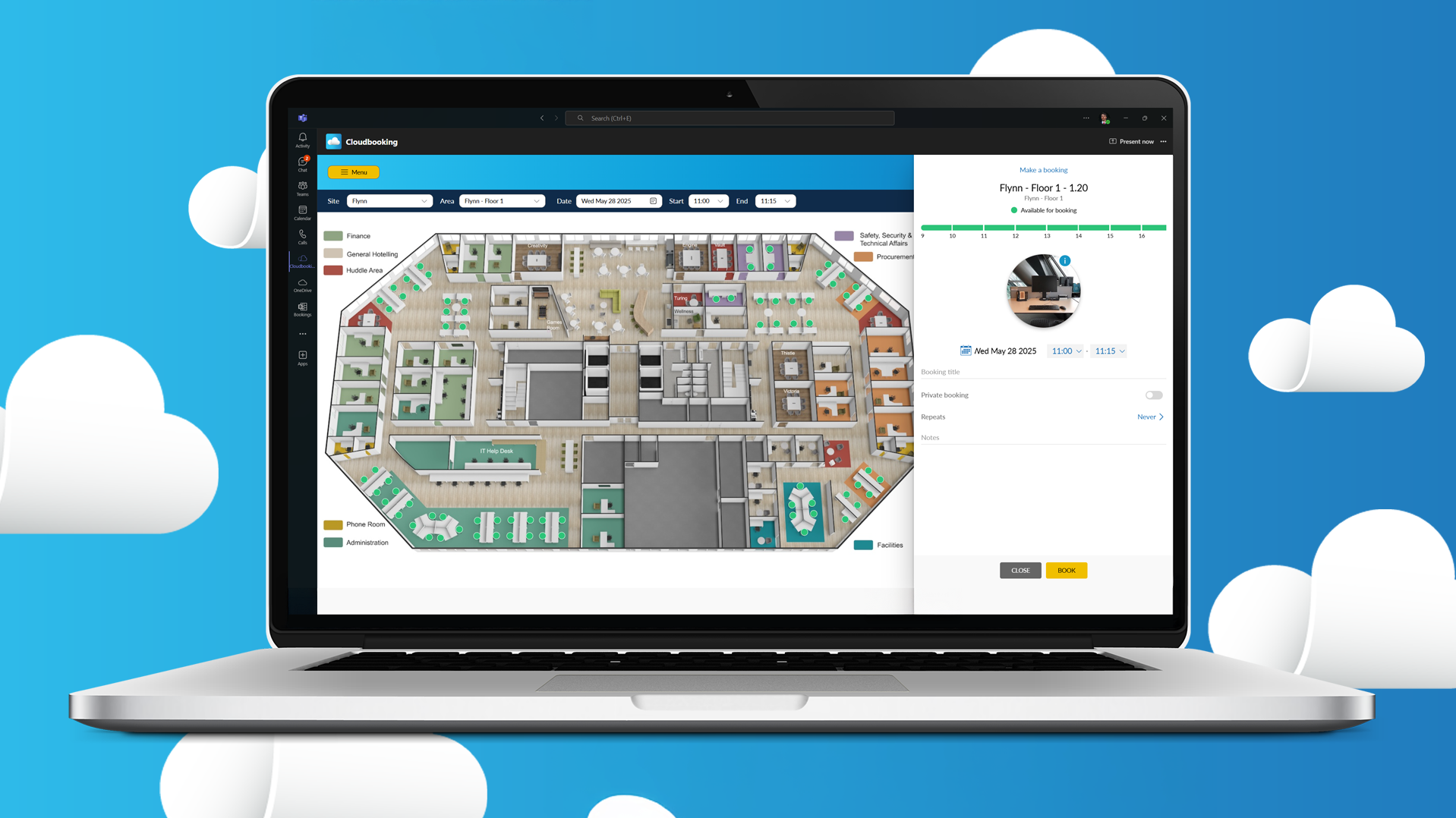
There has recently been a distinct rise in productivity apps and tools being used in the workplace. This has also transcended to company employees working at home. They have proved invaluable, especially in recent months, in keeping motivation and productivity high. They are a great way of monitoring what is being done.
Get a free demo
Enquire about a no-obligation demo today and get an exclusive hybrid working research paper — for free. Created in partnership with YouGov, this invaluable guide provides essential insights into developing your own effective hybrid strategy. Click below.
These productivity apps and tools not only help employees to stay on track with their tasks and communicate effectively but also help managers too. This article will talk about the hybrid working model swiftly becoming prominent in the workplace. Here at Cloudbooking, we will also discuss how these tools help businesses working with this hybrid model to achieve effectiveness.
Cloudbooking’s latest webinar series discusses the hybrid working model with expert industry leaders, including Cloudbooking’s CEO, Gerry Brennan. In the webinar, the guest speakers discuss Cloudbooking’s recent report, ‘The Hybrid Workplace: An Employee Census.’ Together with YouGov, we questioned over 2000 employees from the US and UK on everything from the return to work, well-being, and remote working pressures.
Introduction to Hybrid Working
The hybrid working model is precisely what you would expect it to be – a work style with a hybrid element. The hybrid aspect, in this case, is that this work style enables employees to blend their working locations. Whether they are in the workplace, at home or on the go, they can access work anytime and anywhere.
It is a location flexible arrangement and allows employees and employers to combine both remote and office work in a way that works for them. This means companies can retain employees and increase motivation and productivity. After all, everyone should be happy with how they are performing.
If a hybrid work model is effective, it will encourage flexibility, high performance, and efficiency, among other things. It helps employees find a way to work that suits their needs, have a better work-life balance and doesn’t affect the company performance. This also means companies retain their top talent more as they are happier and more motivated to do their work.
Hybrid working has become increasingly popular since the pandemic where many people had to work from home. Now that workplaces are opening up, not all of the workforce wants to go back into the physical office. This means that many companies have to adjust, and many have opted for a hybrid working policy.
Previously, many companies didn’t believe they could work remotely, but the pandemic showed that they could. Through the use of productivity apps and tools such as Cloudbooking, companies have established this hybrid model with little difficulty. Hybrid working offers flexibility to companies and workers that they never thought they had before.
Many employees have also found the model has helped with their productivity. With the option of working from home or in the office available to them, they have found it much more motivating. Below, we will look at the types of hybrid working models and the challenges faced. We will also look at how the hybrid working model works and how to ensure it works well.
The Types of Hybrid Working Models
There are a few different variations of the hybrid working model — it isn’t as simple as half of the team at home and some in the office or workplace. These models are sometimes given different names, which we will explain below.
-
Remote-first
The first type is remote-first which sees the company as almost entirely remote except for a few exceptions. Companies working to this model tend to keep the office space open for employees to work from. Online communication is the default in this case, and employees can be spread far and wide. There are many big businesses currently utilizing this approach.
-
Office occasional (the split week model)
Another variation is the office occasional type. Some companies could not wait to get back to their office space and utilize it once more. Office occasional allows employees to come into the workplace for a set amount of time per week, and they would then work from home for the remaining time. Employees can, of course, spend more time in the office if they want to. This model must have clear guidelines and best practices, so workers know what they are doing and when they can come into the office.
This model is also sometimes known as the split-week model, and it is the model seen among the highest proportion of employees. It allows managers to stay in touch with their remote teams regularly and allows for face-to-face meetings.
-
At-will model
There are a few other variations based on this type. The at-will model lets employees choose the arrangement that works best for them each day. There is also the shift work option where people alternate working from home and in the office or workplace.
Lastly, week by week, this particular variation sees them alternate between home and office weekly. This variation tends to be used when employees need to get together in person for meetings or deadlines.
-
Office first
Office first but remote allowed is another prevalent variation. This type has the office as the primary place of working however does offer a remote work policy for those who want to continue working from home.
As you can see, there are a few different variations of the hybrid working model. Each company considering utilizing the hybrid work model needs to determine which variation would work best for them. It needs to be suitable for the company and the workforce who may be in many different locations.
One hybrid working model may work for one company but not another. Companies must work out the most effective variation for their needs. An effective working model means happy management and a happy workforce.
The Challenges of Hybrid Work
As with all types of work, the hybrid work model doesn’t come without challenges. These challenges can often be caused when the model isn’t implemented correctly. Challenges of remote and hybrid work include:
- Managing a widely distributed workforce
- Monitoring employees who do not want to be monitored
- Leaving out remote workers from meaningful conversations or decisions can breed resentment
- Overcoming collaboration barriers and allowing everyone to have their input at a time that suits everyone.
Managers have to supervise a workforce that may be widely distributed, which means everything will need to be scheduled in advance. This could cause them stress if the model isn’t working as effectively as it should be.
Managing a split team effectively can be done as long as employees are kept motivated and well connected. If they can communicate effectively with those in the workplace, there is no reason why managing a split workforce should be stressful.
There is also the possibility that employees may feel unnecessarily spied upon. A study found that many employers increased their use of monitoring software in recent months. If employees know about this, they may feel like they are being spied on and reluctant to continue working remotely.
Another possibility is that those working away from the office may feel like they are being left out. Employees working in the office together will spend more time together, which may cause resentment from those working elsewhere.
A challenge that is especially important to overcome is the barriers to collaboration. With some people in an office space and some people at home, collaboration may seem an impossibility. Remote employees miss out on spontaneous communication and collaboration.
Opportunities need to be created for workers to connect and offer support or guidance to each other. This can be carried out by regularly organizing simple team meetings, team-building events, and even in-person parties and conferences. By encouraging this sort of collaboration, your company should build a healthy culture that employees want to be part of.
However, these challenges are unlikely to be a problem if the hybrid work model is effective. If remote workers are encouraged to be flexible but motivated, there is no need to monitor them in great detail, nor is there a need for stress. Also, making sure everyone is involved when they need to be will quell feelings of resentment and missing out.
How to Make The Hybrid Work Model, Work
Although the hybrid working model and its different variations can have its challenges, it can certainly work effectively. A few things need to be considered to make the model work, and if these are implemented effectively, there is no reason why the hybrid work models shouldn’t be successful.
It is essential to consider where the leadership team spends their time to distinguish which variation works best. A leadership team that works mainly in the office would benefit most from the office first model. However, a group in which team members are all spread out may work better with the remote-first model.
Any company considering the hybrid working model should undoubtedly consider going remote-first, to begin with. It seems that working remotely will remain important for many people for the foreseeable future, and this model is the strongest. When asked to choose, a great many hybrid workers have chosen to remain remote. It enables every employee to be on the same level, and no one is missing out on essential conversations or decisions.
It is also important to recognize employees equally, whether they are working in the office as a physical presence or remotely. Studies have shown that office workers are most likely to be identified, which could challenge the model. By recognizing and promoting equality, no one employee can ever feel that they are being looked over.
Another way to make the model work is to be consistent with the experience each worker has. Setting guidelines in place so all communication is online means fewer issues are likely to arise. It is essential that fully remote workers must be included with in-office employees in the critical conversations and decisions made.
By utilizing different productivity tools and apps, workforces can communicate well and collaborate, no matter their location. Scheduling apps help everyone know what they need to do, and others help keep them motivated and on track.
Ensuring the hybrid model works is a great way to retain staff, too, as workplace flexibility often increases job satisfaction. Effective hybrid working models have also been seen to improve employees’ mental health and wellbeing, which is, of course, a significant positive.
If your business uses the hybrid working model, Cloudbooking can support you with its innovative desk booking and meeting room booking solutions. No matter what help you need, the team would be happy to support you with your working requirements.
Take a step towards the future of the workplace with Cloudbooking and adopt the latest work models. With hybrid work models, you can offer employees greater flexibility, improved employee wellbeing and greater job safety thanks to the resilient and adaptable way of working.
Find out how Cloudbooking can help you create the ideal hybrid working environment for your employees. Contact us today for a no-obligation product demo.


